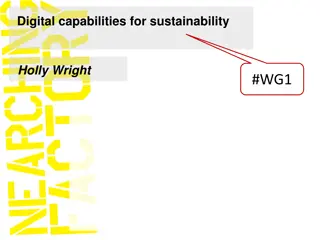Analyzing Questionnaire Data for School Sustainability Enhancement
Explore ways to analyze questionnaire data to assess school sustainability and make informed decisions for improvement. Learn about different types of graphs, constructing tally tables, creating bar charts, line graphs, and pie charts to visually represent data effectively. Develop critical thinking, problem-solving, decision-making, and numeracy skills through hands-on activities in this global citizenship challenge lesson.
Download Presentation

Please find below an Image/Link to download the presentation.
The content on the website is provided AS IS for your information and personal use only. It may not be sold, licensed, or shared on other websites without obtaining consent from the author.If you encounter any issues during the download, it is possible that the publisher has removed the file from their server.
You are allowed to download the files provided on this website for personal or commercial use, subject to the condition that they are used lawfully. All files are the property of their respective owners.
The content on the website is provided AS IS for your information and personal use only. It may not be sold, licensed, or shared on other websites without obtaining consent from the author.
E N D
Presentation Transcript
Global Citizenship Challenge http://sustainability.rpi.edu/images/sustainability_studies.jpg Lesson 4
Lesson Objective Nod y wers To analyse questionnaire data in order to identify if your school is sustainable. To use your research to identify and make decisions on ways to improve the schools sustainability. Skills Objective - Sgiliau Critical Thinking, Problem Solving, Decision Making and Numeracy.
Starter Activity In talking partners discuss and list the different types of graph you could use to display the results from your questionnaire. Think back to your maths/numeracy lessons to help you here. Write your answers on page 11 of your booklet. Types of graphs to display data
How to analyse data Make a tally table to show the data gathered for each closed questions. i.e. Question 1 : Are you male or female? Male Female 6 9 Question 2 : What is your favourite fruit? Apple Orange Pear Banana Grapes Other 5 2 1 4 0 3
Bar charts Use a bar chart to compare two or more values with a small set of results. Drawing a bar chart In a bar chart, the height of the bar shows the frequency of the result. As the height of bar represents frequency, label the vertical axis 'Frequency'. The labelling of the horizontal axis depends on what is being represented by the bar chart.
Line graphs A line graph is often used to show a trend over a number of days or hours. It is plotted as a series of points, which are then joined with straight lines. The ends of the line graph do not have to join to the axes.
Pie charts Pie charts use different-sized sectors of a circle to represent data. To construct a pie chart you need to work out the fraction of the total that the sector represents. You can then convert this to an angle and draw the sector on the chart.
Constructing a pie charts Example The table below shows the grades achieved by 30 pupils in their end-of-year exam. To show this information in a pie chart, take the following steps: Work out the total number of pupils: 7 + 11 + 6 + 4 + 2 = 30 To work out the angle of each segment, work out the fraction of the total that got each grade. Start with A grades: 7 /30 There are 360 in a full turn, so to work out the angle, multiply the fraction by 360: 7 /30 360 = 84 The grade A sector has an angle of 84 Repeat this process to find the angle of the segments for the other grades Once you have calculated the angles of the segments, construct the pie chart
What graph do I use? Make a graph for each tally table, (use a sensible graph) i.e. Question 1 : Are you male or female? Male Female 6 9 10 A graph to show the sex of people asked 8 6 Male Female 4 2 0 male female
Analysing your data Task 1: Using these different strategies of analysing data, you must now look at your own questionnaires. You must: 1. Create tally charts and input the data you have collected 2. Decide what graph is the most suitable to display the data you have collected
Analysing your results Once you have displayed your results it is important to write about them. When we describe any results it is important that we pick out any trends or patterns, we call this an ANALYSIS. When we write an analysis it is important that we consider the following things: The highest and lowest results The overall trend Any smaller trends Mode, median, mean, range Task: Using information from the following slides, write down the word equation for the terms listed on page 12.
Other methods of analysing data The mean The mean is the most common measure of average. To calculate the mean add the numbers together and divide the total by the amount of numbers: Mean = sum of numbers amount of numbers
Other methods of analysing data The median If you place a set of numbers in order, the median number is the middle one. If there are two middle numbers, the median is the mean of those two numbers.
Other methods of analysing data The mode The mode is the value that occurs most often. The mode is the only average that can have more than one value. When finding the mode, it helps to order the numbers first.
Other methods of analysing data The range The range is the difference between the highest and lowest values in a set of numbers. To find it, subtract the lowest number in the distribution from the highest.
Analysing a graph good practice This line graph shows the midday temperature over a period of 7 days. The line graph shows that the temperature over seven days fluctuates. From Sunday to Monday the temperature increases by 2 degrees. From Monday to Thursday there is a decrease in temperature form 28 degrees to 19 degrees. From Thursday to Saturday the temperature again increases from 19 to 27 degrees. The range of temperature shown in the graph is 9 degrees; the mean temperature is 24.2 degrees. The highest temperature in the week was on Monday and the lowest temperature was on Thursday. Fluctuate=to rise and fall or go up and down randomly.
Plenary: How did you use your decision making skills today? How did you use your problem solving skills today? How have you effectively analysed your data? Can you give an example of analysing a graph? What would you use?























